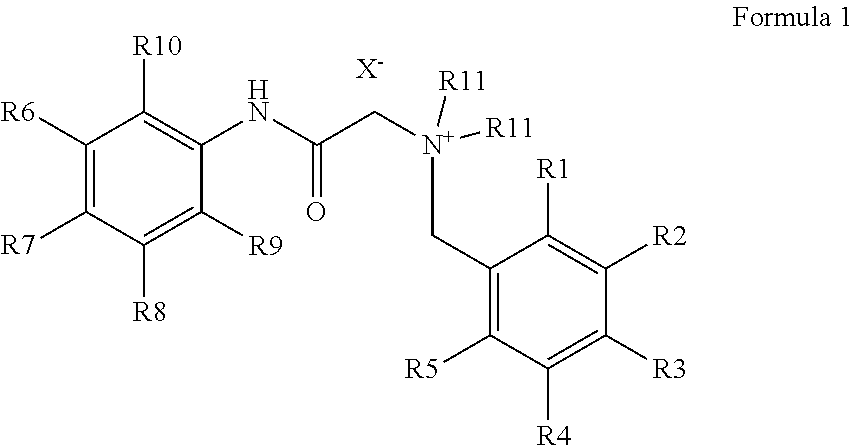Production of bitter principle derivatives
a technology of bitter principle and derivatives, which is applied in the preparation of carbamic acid derivatives, carboxylic acid amides, organic chemistry, etc., can solve the problems of unsolved covalent binding of bitter principles for the development of further fields of application so far, and the derivatization of natural bitter principles is uneconomical
- Summary
- Abstract
- Description
- Claims
- Application Information
AI Technical Summary
Benefits of technology
Problems solved by technology
Method used
Image
Examples
example 1
Reaction of Lidocaine with 4-(bromomethyl)benzoic Acid Methyl Ester
[0051]A small excess of 4-(bromomethyl)benzoic acid methyl ester (18 mg, 80 μmol) was added to 17 mg of lidocaine (72.5 μmol) and it was suspended in 3 ml of water. The suspension is left for 30 min at 200° C. in the microwave. Subsequently, the solution is concentrated to a small volume and taken up in 1 ml of THF. The white solid formed is filtered off and washed with THF. 2-(2,6-Dimethylphenylamino)-N,N-diethyl-N-(4-(methoxycarbonyl)benzyl)-2-oxoethane ammonium bromide is obtained.
example 2
Reaction of Lidocaine with 4-(bromomethyl)benzoic Acid
[0052]1 g of lidocaine (4.3 mmol) was mixed with 0.92 g (4.3 mmol) of 4-(bromomethyl)benzoic acid while shaking. To complete the reaction it was heated for 20 Minutes to 50° C. Subsequently, 10 ml of THF were added and stirred. The white precipitate formed was filtered off, washed with THF and dried. The substance was separated from the by-product lidocaine-4-(bromomethyl)benzoate formed by column chromatography and N-(4-carboxybenzyl)-2-(2,6-dimethylphenylamino)-N,N-diethyl-2-oxoethane ammonium bromide was obtained.
example 3
Synthesis of 2-(2,6-dimethylphenylamino)-N,N-diethyl-N-(3-(methoxycarbonyl)benzyl)-2-oxoethane Ammonium Bromide
[0053]1 g of lidocaine (4.3 mmol) is combined with 0.98 g (4.3 mmol) of 3-(bromomethyl)benzoic acid methyl ester and shaken several times at room temperature within 10 minutes after having been added. Subsequently, 10 ml of THF are added and stirred. The white precipitate formed is filtered off, washed with THF and dried. 2-(2,6-Dimethylphenylamino)-N,N-diethyl-N-(3-(methoxycarbonyl)benzyl)-2-oxoethane ammonium bromide is obtained.
[0054]m.p.: 183-184° C.
[0055]MS (ESI): m / z=383.233 Da (C23H31N2O3)+
[0056]1H-NMR (DMF-D7, ppm): 1.61-1.64 (t, 6H, 2×CH3); 2.32 (s, 6H, 2×CH3); 2.73-2.78; 2.91-2.95 (CH3, DMF-D7); 3.52 (H2O in DMF); 3.71-3.81 (m, 4H, 2×CH2); 3.94 (s, 3H, O—CH3); 4.68 (s, 2H, CH2); 5.20 (s, 2H, CH2); 7.13-7.16 (m, 3H, 3×CH); 7.72-7.75 (t, 1H, CH); 8.03 (CH, DMF); 8.08-8.10 (d, 1H, CH); 8.16-8.18 (d, 1H, CH); 8.38 (s, 1H, CH); 10.87 (s, 1H, NH)
[0057]13C-NMR (DMF-D7, p...
PUM
| Property | Measurement | Unit |
|---|---|---|
| temperature | aaaaa | aaaaa |
| temperature | aaaaa | aaaaa |
| temperature | aaaaa | aaaaa |
Abstract
Description
Claims
Application Information
 Login to View More
Login to View More - R&D
- Intellectual Property
- Life Sciences
- Materials
- Tech Scout
- Unparalleled Data Quality
- Higher Quality Content
- 60% Fewer Hallucinations
Browse by: Latest US Patents, China's latest patents, Technical Efficacy Thesaurus, Application Domain, Technology Topic, Popular Technical Reports.
© 2025 PatSnap. All rights reserved.Legal|Privacy policy|Modern Slavery Act Transparency Statement|Sitemap|About US| Contact US: help@patsnap.com



